Sour milk odor comes from bacteria like Lactobacillus that ferment lactose, producing acids such as lactic, acetic, and butyric acids, which create that sharp, rancid smell. To clean it up, wipe affected areas with warm water and soap, then neutralize odors with vinegar or baking soda. Ventilate your space and consider enzymatic cleaners for lasting results. If you keep exploring, you’ll discover more effective ways to prevent and eliminate sour milk odors safely.
Key Takeaways
- The sour milk odor results from volatile acids like lactic and acetic acids produced by bacterial fermentation.
- Proper cleanup involves cleaning surfaces with warm water and soap, then neutralizing odors with vinegar or baking soda.
- Enzymatic cleaners break down odor-causing molecules, providing permanent neutralization of sour milk smells.
- Ventilation and air circulation help disperse airborne odor molecules effectively.
- Dispose of spoiled milk promptly if it exhibits strong sour smell, curdling, discoloration, or slimy texture.
The Chemistry Behind Sour Milk Formation

When milk sours, it’s primarily due to the activity of bacteria that ferment lactose, the natural sugar found in milk. These bacteria, mainly lactic acid bacteria like Lactobacillus and Streptococcus, consume lactose and produce lactic acid as a byproduct. As lactic acid accumulates, it lowers the milk’s pH, making it more acidic. This acidification causes the milk proteins, especially casein, to denature and curdle, resulting in the thickened, tangy texture characteristic of sour milk. The process begins quickly once bacteria are introduced, especially if the milk isn’t stored properly. Temperature plays a significant role; warmer conditions accelerate bacterial activity and the souring process. Understanding this chemistry helps you grasp why milk turns sour and how bacteria drive this transformation. Additionally, factors like storage conditions and temperature can influence the speed and extent of souring.
Key Compounds Responsible for the Odor
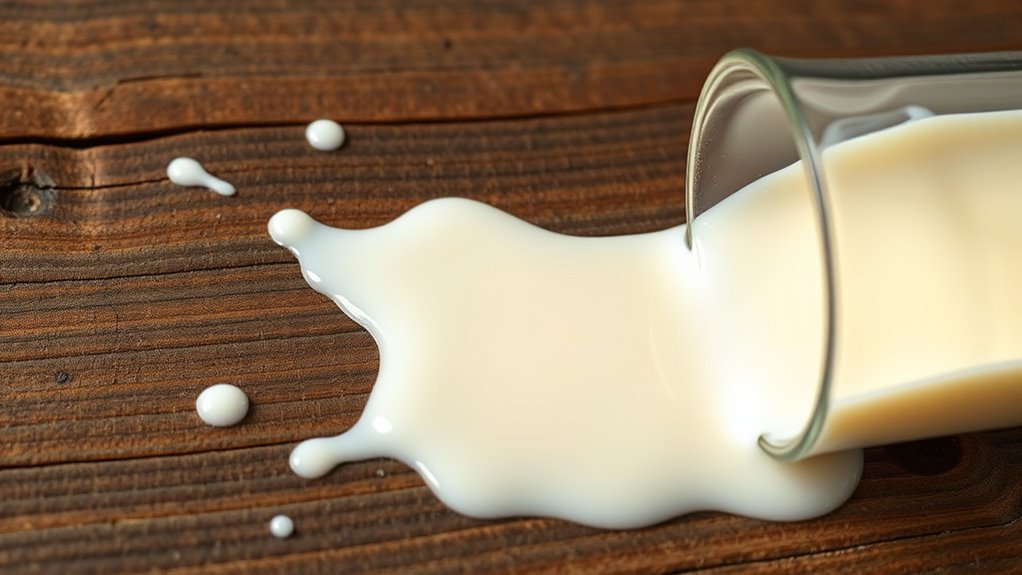
The sour milk odor mainly arises from a group of volatile compounds produced during bacterial fermentation. These compounds include lactic acid, which gives sour milk its tangy smell, and other volatile acids like acetic acid, responsible for vinegar-like notes. Short-chain fatty acids such as butyric and propionic acid contribute to the pungent, rancid odor. Additionally, compounds like diacetyl add a buttery aroma, while hydrogen sulfide introduces a rotten egg smell. These molecules are volatile, meaning they easily evaporate into the air, making the odor noticeable. The specific combination and concentration of these compounds determine the intensity and character of the sour milk smell. Understanding these key compounds helps in identifying and managing odor issues effectively. Residency requirements for legal actions can influence the timing and process of addressing odor complaints.
How Bacteria Contribute to Sour Milk
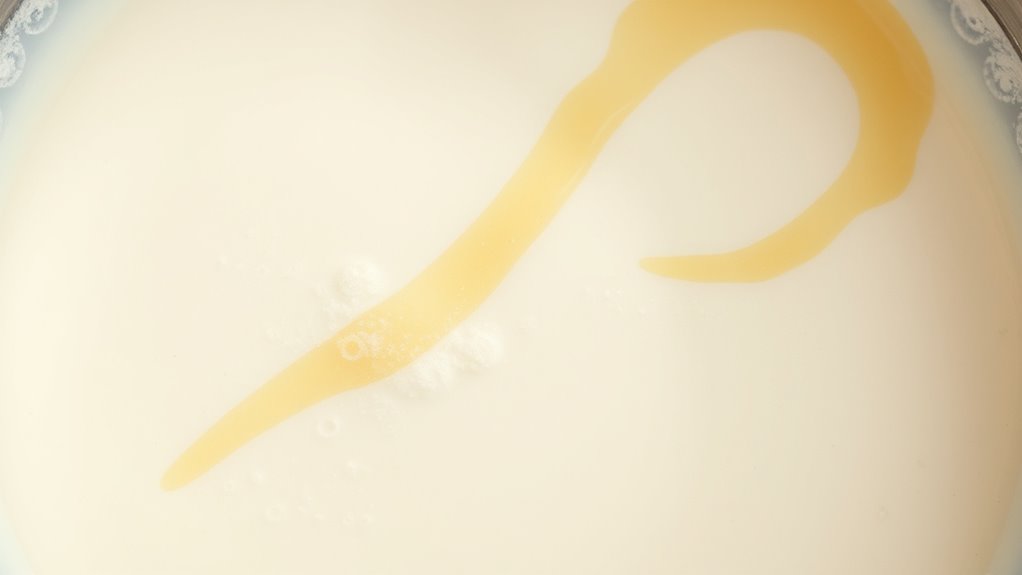
Bacteria play a crucial role in transforming fresh milk into sour milk by breaking down lactose, the milk’s primary sugar. They do this through a process called fermentation, where enzymes convert lactose into lactic acid. As bacteria consume the sugar, lactic acid accumulates, lowering the milk’s pH and making it more acidic. This acidification causes the milk to develop its characteristic sour taste and smell. Different bacteria strains, like Lactobacillus and Streptococcus, are responsible for this process. Their activity not only changes the flavor and texture but also creates the environment that prevents harmful bacteria from growing. Essentially, these bacteria are the natural agents that turn fresh milk into sour milk, shaping its aroma and safety profile. Understanding microbial activity is essential for controlling the fermentation process and ensuring product safety.
Recognizing the Signs of Spoiled Milk

Spotting spoiled milk is straightforward if you know what to look for. First, check the smell—spoiled milk emits a strong, sour odor that’s hard to miss. If it smells off or unpleasant, it’s a clear sign it’s gone bad. Next, look at the appearance; spoiled milk often appears lumpy, curdled, or has a thickened texture. The color may also change from white to yellowish or grayish. Feel the consistency—if it feels slimy or unusually thick, that’s another warning sign. Finally, trust your senses—if anything seems abnormal, it’s best to discard the milk. Recognizing these signs early helps prevent consumption of spoiled dairy and reduces the risk of foodborne illnesses. Always err on the side of caution when in doubt. Additionally, understanding nail styles names can help you identify trends and choose the right look for your personality.
Effective Methods to Remove Sour Milk Odors
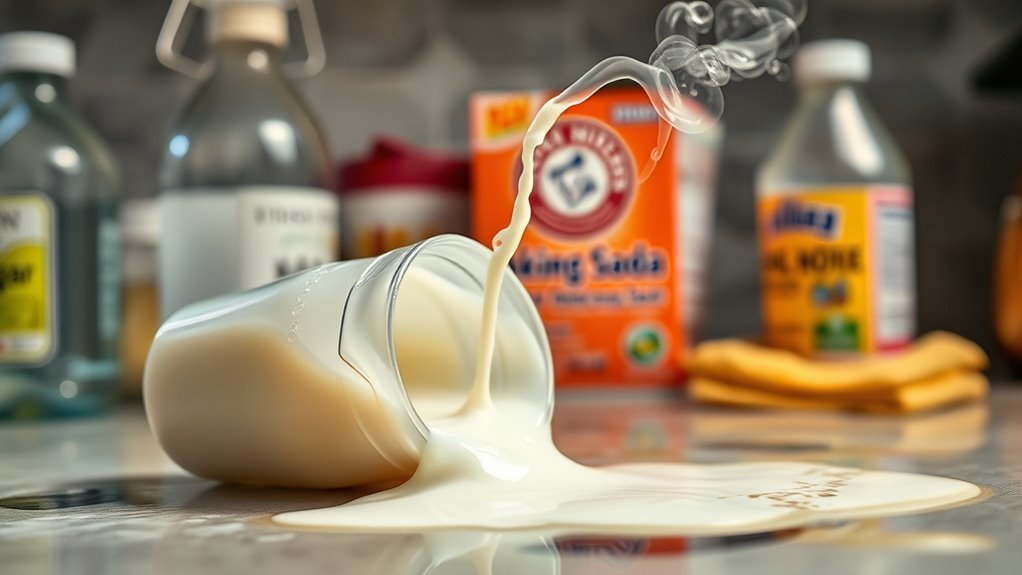
Removing sour milk odors can be effective if you use the right techniques. Start by cleaning the affected area thoroughly with warm water and soap, then follow up with an odor-neutralizing solution. Vinegar or baking soda are excellent options for absorbing and neutralizing smells. For stubborn odors, consider rinsing with a mixture of water and white vinegar, then air drying. Use fans or open windows to promote ventilation, speeding up odor removal. To understand the importance of these methods, consider this table:
| Technique | Purpose | Effectiveness |
|---|---|---|
| Vinegar rinse | Neutralize acids in odor | High for persistent smells |
| Baking soda | Absorb and deodorize | Quick and natural |
| Ventilation | Remove airborne odor particles | Essential for complete cleanup |
| Thorough cleaning | Remove residue and bacteria | Foundation of odor removal |
Additionally, proper ventilation techniques can significantly enhance the overall odor elimination process by dispersing airborne molecules more efficiently.
Natural Cleaning Solutions for Freshening Up

After thoroughly cleaning the affected area, you can enhance freshness using natural cleaning solutions that are safe and eco-friendly. White vinegar is a top choice; its acidity neutralizes odors and disinfects surfaces. Mix equal parts vinegar and water in a spray bottle, then spritz the area and let it sit for a few minutes before wiping clean. Baking soda is another effective option; it absorbs stubborn odors. Sprinkle it generously over the surface, let it sit for 15-30 minutes, then vacuum or wipe away. Lemon juice offers a fresh scent and natural antibacterial properties. Dilute lemon juice with water, apply with a cloth, and wipe down the area. These solutions are affordable, non-toxic, and environmentally friendly, making them ideal for freshening up your space naturally.
Commercial Products for Odor Elimination

Commercial odor eliminators can be highly effective at neutralizing sour milk smells. You might choose from enzymatic cleaning agents that break down odor-causing molecules or sprays that absorb odors on contact. Understanding these options helps you select the right product to keep your space smelling fresh. Additionally, selecting products designed to prevent clogging and buildup can improve their efficacy and longevity.
Effective Odor Neutralizers
When dealing with sour milk odors, choosing the right odor neutralizer can make all the difference. Commercial odor neutralizers are formulated to target and eliminate stubborn smells effectively. Look for products containing active ingredients like activated charcoal, baking soda, or specific odor-neutralizing compounds such as cyclodextrins. These substances trap or chemically neutralize odor molecules, providing quick relief. Sprayable solutions, foams, or gels can be applied directly to contaminated surfaces, fabrics, or carpets. Guarantee the product is suitable for your specific material to avoid damage. Read labels carefully and follow application instructions. Combining a reliable neutralizer with good ventilation accelerates odor removal. Investing in quality odor neutralizers simplifies the cleanup process and restores freshness faster.
Enzymatic Cleaning Agents
Enzymatic cleaning agents are highly effective tools for eliminating sour milk odors because they naturally break down organic compounds that cause persistent smells. These products contain specific enzymes that target proteins, fats, and carbohydrates found in spoiled milk residues. When applied to affected surfaces or fabrics, the enzymes rapidly digest the odor-causing molecules, neutralizing the smell at its source. Unlike chemical deodorizers that mask odors, enzymatic cleaners offer a biological solution that permanently breaks down the organic matter responsible for sour milk smells. They are safe for most surfaces and fabrics, making them versatile for different cleanup situations. Additionally, the effectiveness of enzymatic cleaners can be influenced by the contrast ratio of the environment, as proper lighting and surface conditions can enhance their performance. To get the best results, follow the manufacturer’s instructions regarding application and dwell time, ensuring thorough contact with the odor source.
Odor Absorbing Sprays
Odor absorbing sprays are a popular choice for quickly neutralizing sour milk smells in various settings. These sprays work by trapping and neutralizing odor molecules on contact, providing instant relief. When selecting a spray, consider factors like scent neutrality, surface compatibility, and spray strength. Some sprays are designed for fabrics, while others work better on hard surfaces. Here’s a quick comparison:
| Product Type | Suitable Surfaces | Key Feature |
|---|---|---|
| Commercial Air Fresheners | Air and fabrics | Long-lasting scent masking |
| Odor Neutralizing Sprays | Hard surfaces, upholstery | Chemical odor neutralization |
| Enzymatic Sprays | Organic stains, fabrics | Breaks down odor-causing molecules |
Choose the right one based on your needs to eliminate sour milk odors effectively. Additionally, selecting the appropriate odor elimination method can help prevent lingering smells over time.
Preventing Sour Milk Odors in Your Refrigerator

To prevent sour milk odors from developing in your refrigerator, maintaining proper storage and a clean environment is essential. Always keep milk and dairy products tightly sealed in their original containers or airtight jars to prevent leaks and spills that can cause odors. Store milk on the middle or upper shelves, where temperatures stay consistent, rather than the door, which experiences frequent temperature fluctuations. Regularly check for expired or spoiled items and promptly discard them to avoid odor transfer. Wipe down shelves and drawers with mild cleaning solutions weekly to remove any residue. Keep the refrigerator at the recommended temperature of around 37°F (3°C) to slow bacterial growth. Proper refrigerator organization can help ensure proper airflow and prevent cross-contamination that leads to odors. By following these steps, you reduce the risk of sour milk odors spreading throughout your fridge.
Tips for Proper Storage of Dairy Products
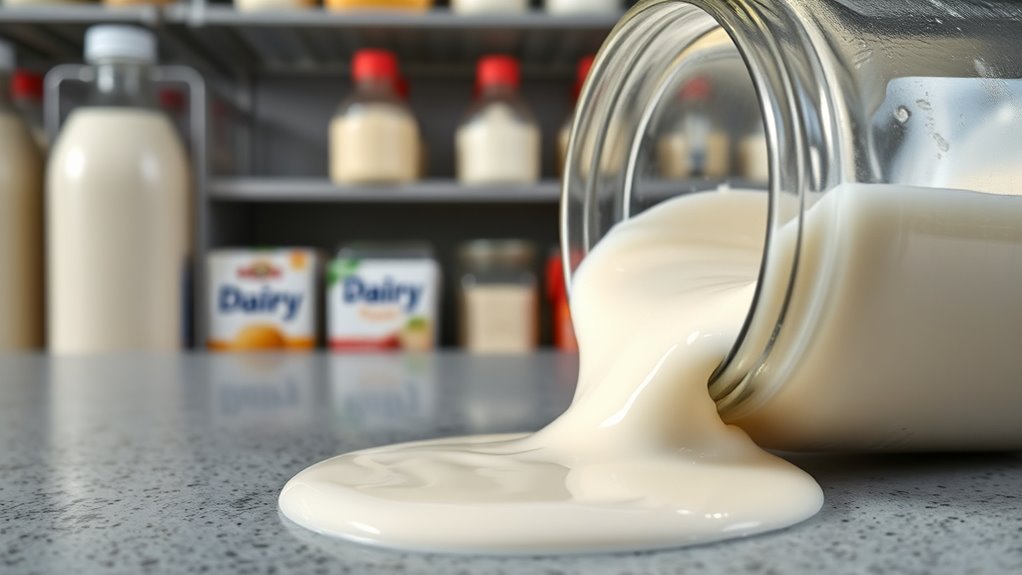
Proper storage of dairy products begins with choosing the right containers and placement within your refrigerator. Use airtight containers or original packaging to prevent odor transfer. Store dairy on the middle or lower shelves where temperatures are most consistent, avoiding the door, which experiences temperature fluctuations. Keep dairy products away from strong-smelling foods like onions or garlic to prevent odor absorption. Maintaining proper refrigeration temperatures can further help preserve freshness and prevent spoilage.
When to Discard Sour Milk Safely
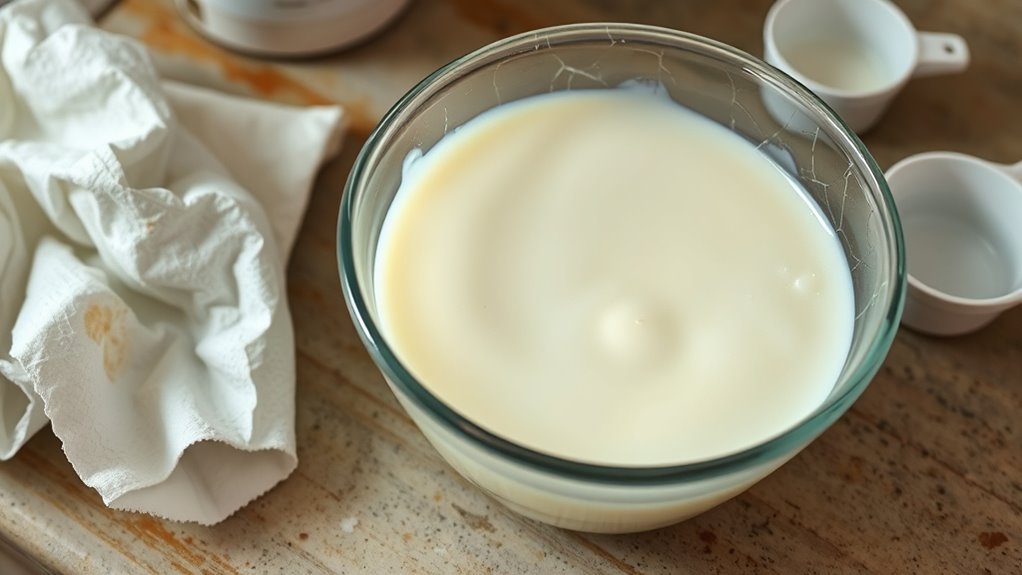
You should discard sour milk promptly once it shows signs of spoilage to prevent health risks. If it smells strongly sour or has a rancid odor, it’s time to toss it. Look for curdling or separation that doesn’t mix back together when stirred. Any change in color, such as yellowing or dullness, indicates spoilage. A slimy texture or clumping also signals it’s past its prime. Trust your senses—if the milk tastes off or causes discomfort, discard it immediately. Don’t consume milk beyond its expiration date, even if it looks and smells okay. Properly disposing of spoiled milk helps prevent the growth of harmful bacteria and reduces the risk of foodborne illness. When in doubt, it’s safer to discard and replace with fresh milk.
Frequently Asked Questions
Can Sour Milk Odor Indicate Underlying Health Issues?
If you notice a sour milk odor, it’s usually just from spoiled dairy, but it can sometimes signal underlying health issues like infections or digestive problems. You should pay attention if the smell persists despite cleaning or if you experience symptoms like nausea, stomach pain, or other changes. In such cases, it’s wise to consult a healthcare professional to rule out any health concerns linked to the odor or your overall well-being.
Are There Safe Home Remedies to Neutralize Sour Milk Smell?
Ever wondered if you can banish that stubborn sour milk smell at home? You can! Start by wiping surfaces with a mixture of equal parts white vinegar and water—it’s like a magic potion that neutralizes odors. Baking soda is your trusty ally; sprinkle it on affected areas, let it sit, then vacuum or wipe away. These simple remedies turn your space fresh without risking your health.
How Long Does It Take for Sour Milk Odor to Dissipate Naturally?
You wonder how long it takes for sour milk smell to fade naturally. Typically, the odor dissipates within a few days to a week, especially if you ventilate the area well. As the smell evaporates, fresh air helps speed up the process. Cleaning the affected surface can also reduce lingering odors. Keep in mind, the exact time depends on temperature, humidity, and how well you ventilate your space.
Can Sour Milk Odor Damage Household Appliances or Surfaces?
You might wonder if sour milk odor can harm your appliances or surfaces. Generally, the smell alone doesn’t cause damage, but if the milk spills and isn’t cleaned promptly, it can lead to staining, mold, or corrosion over time. To protect your appliances and surfaces, clean up spills quickly with soap and water and consider using a vinegar solution. Proper cleanup prevents lingering odors and potential damage.
Is It Safe to Use Expired Milk for Baking Despite the Smell?
Think of expired milk as a warning sign, much like a red flag in a storm. If it smells sour, it’s best to heed that warning. Using expired milk for baking might seem harmless, but the sour smell indicates bacteria growth, which could affect your health. Trust your senses—if it smells off, it’s safer to discard it. Better safe than sorry, especially in your kitchen.
Conclusion
Understanding the chemistry behind sour milk helps you catch spoilage early and tackle odors effectively. By recognizing the key compounds and bacterial activity, you become the guardian of freshness in your kitchen. With the right cleaning methods and storage tips, you can keep your fridge smelling like a spring breeze rather than a dairy disaster. Think of it as tending a delicate garden—your vigilance guarantees every dairy product stays pristine, and your space remains inviting and fragrant.









